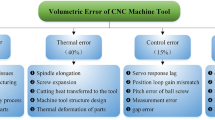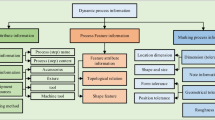Abstract
In the field of free form surface machining, CAM software allows management of various modes of tool-path generation (zig-zag, spiral, z-level, parallel plan, iso-planar, etc.) leaning on the geometry of the surface to be machined. Various machining strategies can be used for the same shape. Nevertheless the choice of a machining strategy remains an expert field. Indeed there are no precise rules to facilitate the necessary parameter choice for tool-path computation from analysis of the numerical model of a part and the quality requirements. The objective of this paper is to provide a method to assist in the choice of the machining direction for parallel plane milling of sculptured parts. The influence of the tool-path on final quality according to the intrinsic geometrical characteristics of the latter (curves, orientation) was studied. Directional beams are introduced and defined from the local surface parameter. Finally, a methodology to optimize machining time while guaranteeing a high level of quality was developed and applied to examples.
Similar content being viewed by others
References
Sun G, Sequin CH, Wright PK (2001) Operation decomposition for freeform surface feature in process planning. Comput Aided Des 33:621–636
Lartigue C, Duc E, Tournier C (1999) Machining of free-form surfaces and geometrical specifications. Proc Inst Mech Engr 213:21–27
Chen Z, Dong Z, Vickers GW (2003) Automated surface subdivision and tool path generation for 3 1/2 1/2 axis CNC machining of sculptured parts. Comput Ind 50:319–331
Chiou C-J, Lee YS (2002) A machining potential field approach to tool path generation for multi-axis sculptured surface machining. Comput Aided Des 34:357–371
Held M, Arkin EM, Smith CL (2001) Optimization problems related to zigzag pocket machining. Algorithmica 26:219–236
Kang MC, Kim KK, Lee DW, Kim JS, Kim NK (2001) Characteristics of inclined planes according to the variations of the cutting direction in high-speed ball-end milling. Int J Adv Manuf Technol 17:323–329
Ko TJ, Kim HS, Lee SS (2001) Selection of the machining inclination angle in high-speed ball end milling. Int J Adv Manuf Technol 17:163–170
Lee CM, Kim SW, Choi KH, Lee DW (2003) Evaluation of cutter orientations in high-speed ball end milling of cantilever-shaped thin plate. J Mater Process Technol 140:231–236
Ramos AM, Relvas C, Simões A (2003) The influence of finishing milling strategies on texture roughness and dimensional deviations on the machining of complex surface. J Mater Process Technol 136:209–216
Kim T, Sarma SE (2002) Toolpath generation along directions of maximum kinematic performance; a first cut at machine-optimal paths. Comput Aided Des 34:453–468
Tournier C, Duc E (2002) A surface based approach for constant scallop height. Int J Adv Manuf Technol 19:318–324
Kim KI, Kim K (1995) A new machine strategy for sculptured surface using offset surface. Int J Prod Res 33:1683–1697
Choi K, Jerard RB (1998) Sculptured surface machining theory and application. Kluwer Academic, Dortrecht, The Netherlands
Godet M (2000) The art of scenarios and strategic planning: tools and pitfalls. Technol Forecast Soc Change 65(1):3–22
Feng H-Y, Su N (2000) Integrated tool path and feed rate optimization for the finishing machining of 3D plane surfaces. Int Mach Tools Manuf 40:1557–1572
Bouzakis K-D, Aichouh P, Efstahiou K (2003) Determination of the chip geometry, cutting force and roughness in free form surfaces finishing milling, with ball end tools. Int J Mach Tools Manuf 43:499–514
Kim BH, Chu CN (1998) Texture prediction of milled surface using texture superposition method. Comput Aided Des 31:485–494
Quinsat Y, Sabourin L, Gogu G (2004) Help for sculptured surface machining strategy choice: application to finishing process of sculptured surface. Curr Adv Mech Des Prod 8:1023–1031
Gadelmawla ES, Koura MM, Amaksoud TM, Elewa IM, Solima HH (2002) Roughness parameters. J Mater Process Technol 123:133–145
Dong WP, Sullivan PJ, Stout KJ (1992) Comprehensive study of parameters for characterizing three dimensional surface topography I: some inherent properties of parameter variation. Wear 159:161–171
Dong WP, Sullivan PJ, Stout KJ (1993) Comprehensive study of parameters for characterizing three dimensional surface topography II: statistical properties of parameter variation. Wear 167:9–21
Dong WP, Sullivan PJ, Stout KJ (1994) Comprehensive study of parameters for characterizing three dimensional surface topography IV: parameter for characterising spatial and hybrid properties. Wear 178:45–60
Pateloup V, Duc E, Lartigue C, Ray P (2003) Pocketing optimization for HSM. Geometry tool path and interpolation mode influence on dynamic machine tool behaviour. Mach Eng 3:127–138
Author information
Authors and Affiliations
Corresponding author
Rights and permissions
About this article
Cite this article
Quinsat, Y., Sabourin, L. Optimal selection of machining direction for three-axis milling of sculptured parts. Int J Adv Manuf Technol 33, 684–692 (2007). https://doi.org/10.1007/s00170-006-0515-5
Received:
Accepted:
Published:
Issue Date:
DOI: https://doi.org/10.1007/s00170-006-0515-5




